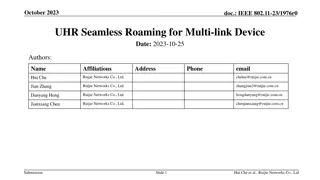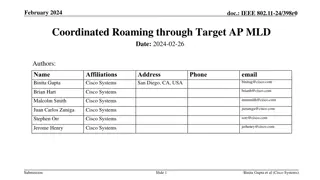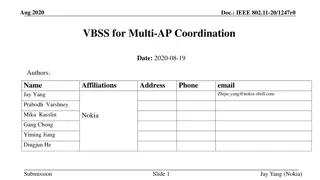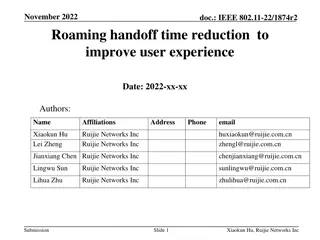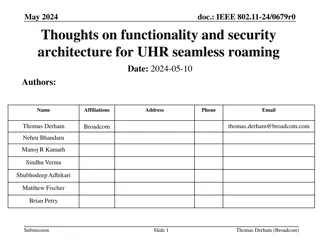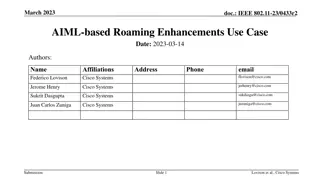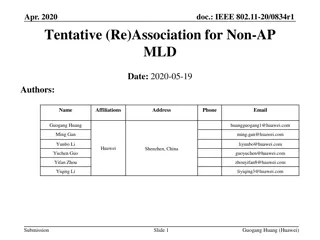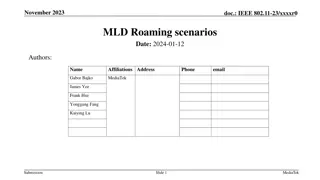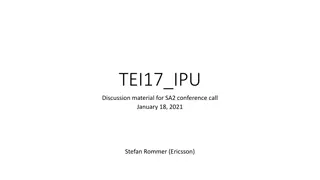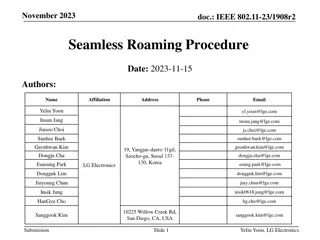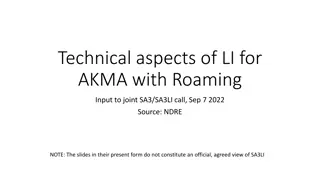
Seamless Roaming Protocol for IEEE 802.11-24/1883r3
Explore the IEEE 802.11-24/1883r3 Seamless Roaming Protocol, designed by Qualcomm, highlighting features like context transfer and buffered data delivery. Learn about the requirements for seamless roaming, including scalability and reliability. Discover the concept of Seamless Mobility Domain (SMD) and how it aids in the smooth transition between Access Points (APs) for uninterrupted connectivity.
Uploaded on | 0 Views
Download Presentation

Please find below an Image/Link to download the presentation.
The content on the website is provided AS IS for your information and personal use only. It may not be sold, licensed, or shared on other websites without obtaining consent from the author. If you encounter any issues during the download, it is possible that the publisher has removed the file from their server.
You are allowed to download the files provided on this website for personal or commercial use, subject to the condition that they are used lawfully. All files are the property of their respective owners.
The content on the website is provided AS IS for your information and personal use only. It may not be sold, licensed, or shared on other websites without obtaining consent from the author.
E N D
Presentation Transcript
Jan. 2025 doc.: IEEE 802.11-24/1883r3 Seamless Roaming Date: 2025-01-15 Authors: Name Affiliations Address Phone email Giovanni Chisci Qualcomm Technologies, Inc. 5665 Morehouse Dr., San Diego CA 92121 gchisci@qti.qualcomm.com Abhishek Patil appatil@qti.qualcomm.com Duncan Ho dho@qti.qualcomm.com George Cherian gcherian@qti.qualcomm.com Alfred Asterjadhi aasterja@qti.qualcomm.com Gaurang Naik gnaik@qti.qualcomm.com Sherief Helwa shelwa@qti.qualcomm.com Sanket Kalamkar sankal@qti.qualcomm.com Submission Slide 1 Giovanni Chisci et al., Qualcomm
Jan. 2025 doc.: IEEE 802.11-24/1883r3 Introduction TGbn has agreed to specify a new mechanism [Jan 2024] for seamless roaming of a non-AP MLD from a current AP MLD to a target AP MLD with the following characteristics: [Jul 2024] Context related to the non-AP MLD can be (at least partially) transferred from the current to the target AP MLD [Jul 2024] After a request/response exchange initiating the DS mapping change, buffered DL data can be: Delivered by the current AP MLD retrieved by the non-AP MLD on the old link Forwarded from the current AP MLD to the target AP MLD so that the non-AP MLD may retrieve it on the new link [Sept 2024] A request/response exchange is defined from a non-AP MLD in state 4 to Transfer the context Perform necessary DS mapping change [Nov 2024] A preparation phase is defined from a non-AP MLD in state 4 to Transfer the context Setup the links with the target AP MLD Submission Slide 2 Giovanni Chisci et al., Qualcomm
Jan. 2025 doc.: IEEE 802.11-24/1883r3 Seamless Roaming requirements Should be seamless No disruption to on-going QoS flows Avoid unnecessary overhead (reduce frame exchange/processing) Reliable roaming (can be prepared in advance and correct expectations are set for clients) Should be scalable To support mobility within a network consisting of large number of APs Should be simple E.g., Rely on existing frameworks as much as possible Should be flexible To cover different use cases such as home, enterprise, warehouse, etc. Submission Slide 3 Giovanni Chisci et al., Qualcomm
Jan. 2025 doc.: IEEE 802.11-24/1883r3 Seamless Mobility Domain (SMD) To fulfill the requirements of Seamless Roaming (SR), one of the key aspects is to identify the group of AP MLDs over which the SR protocol can be used. A Seamless Mobility Domain (SMD) shall be defined and identified with a unique identifier to facilitate the operations involved in the transition between a current AP MLD and a target AP MLD belonging to the same SMD can be carried while referring to such an SMD ID, for example: Discovery of the AP MLDs within the SMD across which the non- AP MLD can use SR Security (single PMKSA/PTKSA) Consistency of BA operation Set up links While SR can provide the most seamless experience within the SMD, it is expected mobility in larger ecosystems (e.g., between SMDs) can be aided by fast BSS transition (FT). FT MD SR AP MLD 2 AP MLD 1 SMD 1 SMD 2 AP MLD 4 SMD 3 FT AP MLD 3 Submission Slide 4 Giovanni Chisci et al., Qualcomm
Jan. 2025 doc.: IEEE 802.11-24/1883r3 Seamless Roaming In Steps To deliver a smooth experience, Seamless Roaming extends over different steps: Discovery: the client discovers the neighboring AP MLDs in the SMD Recommendations: the client can receive recommendations on suitable candidate AP MLDs in the SMD that can meet the client s requirements E.g., considering client s context, loading conditions, check on the backhaul, etc. BTM signaling can be considered, e.g.: BTM query/request solicited BTM request unsolicited Preparation: the client requests the current AP MLD to set up a target AP MLD in the SMD over the backhaul Set up of the links First instance of context transfer Signaling for the client/current AP MLD request/response exchange is TBD (e.g., ML reconfiguration) Execution: the client request to roam to the target AP MLD in the SMD Second instance of context transfer and optionally link reconfiguration If necessary, DS mapping switch Both exchange client-current and client-target AP MLD can be considered (current in the figure) Shall be accepted if request is received within a timeout after Setup completion ML reconfiguration can be considered for signaling (e.g., to cover the case where Preparation is not performed.) Client AP MLD0 AP MLD1 AP MLD2 Discovery/Scanning Recommendations Prep. Request AP MLD 1 Set up links context transfer (1) Prep. Response Prep. timeout (Execution request is accepted if performed within timeout after Prep. completion) Execution request AP MLD 1 context transfer (2) Optional: set up links DS map switch (if necessary) Execution Response Submission Slide 5 Giovanni Chisci et al., Qualcomm
Jan. 2025 doc.: IEEE 802.11-24/1883r3 Discussion on the Roaming Setup Some of the key operations for SR that are expected are Context transfer Link set up Such operations are expected to require some latency (e.g., some tens of ms), therefore it is preferable to avoid service disruption (e.g., interruption of DL/UL communications) while such operations are carried out. TGbn agreed to decouple the request/response exchange for the roaming execution (which can involve DS mapping switch and therefore service interruption) by introducing a Preparation step before Execution (4 messages). The context transfer can initiate at this time. After a successful Preparation, the current AP MLD shall accept the Execution request at least if received within a timeout after Setup completion, in this way the expectation is set for successful roaming execution. The signaling should be consistent between Preparation and Execution (i.e., provision for link addition) Submission Slide 6 Giovanni Chisci et al., Qualcomm
Jan. 2025 doc.: IEEE 802.11-24/1883r3 Security (two security modes) TGbn agreed on single PMKSA/PTKSA as a key feature to obtain a seamless experience for a client that roams when remaining in state 4 with the SMD-ME. First mode: single encryption key (in the single PTKSA) for all AP MLDs within the SMD Since some members expressed security concerns with the PTK sharing in some deployments, extensions of the PTKSA can be considered to provision for a second mode using different (per-AP MLD) TKs for encryption. It is expected that Preparation Req/Resp (via the Current PA MLD) can be used to convey the necessary support for establishing the new TK (e.g., Public Ephemeral Keys and/or Nonces), and after that the new TK can be used to protect the Execution Request/Response (if sent directly to the Target AP MLD) Submission Slide 7 Giovanni Chisci et al., Qualcomm
Jan. 2025 PN Continuation (current assumption) doc.: IEEE 802.11-24/1883r3 To facilitate reordering packets that may come from different AP MLDs during seamless roaming, the PN space can continue (i.e.., monotonically increasing) between the serving AP MLD and the target AP MLD regardless of which TK is used - PN is maintained per PTKSA (which is at the SMD level) - Since we allow TWO TKs during the SR transitional period, the PN continues (thanks to context transfer) and increases monotonically from the serving AP MLD to the AP MLDs regardless of which TK value is used to encrypt the frame. AP AP STA MLD 1 MLD 2 DL w/ PTK 1 TA based key lookup for decryption (same as today) DL w/ PTK 2 Upon completion of its DL, AP1 sends BAR w/ SSN = 1st SN for AP2 SN jump Single Reorder buffer Buffers ordered in increasing SN SN Continuity PN jump PN ordered based on increasing SN Single Reply check PN Continuity Submission Slide 8 Giovanni Chisci et al., Qualcomm
Jan. 2025 doc.: IEEE 802.11-24/1883r3 FT updates An FT MD can include one or more SMDs. When initial secure association is established within an SMD-ME within an FT MD, the secure association is performed such that Seamless roaming can be used within the SMD FT can be used between SMDs The updates of FT consist of the following: The R0KH derives PMK R0 and PMK R1 so that they are bound to the SMD-ME identity (the single PMKSA to be used in the SMD is PMK R1 SA) The R1KH derives PTK R1 according to PMK R1 and is bound to the SMD identity (the single PTKSA to be used in the SMD is PTK R1 SA) Submission Slide 9 Giovanni Chisci et al., Qualcomm
Jan. 2025 Discussion: Execution Request via Current or via Target AP MLD doc.: IEEE 802.11-24/1883r3 Case 1: When the non-AP MLD wished to roam as fast as possible, and/or, lost the signal from the Current AP MLD, it is more appropriate to send a Execution Request to the Target AP MLD. In this case draining of DL data is not performed (e.g., would require switch back on other links, etc.) Case 2: When the non-AP MLD wishes to retrieve DL data from the Current AP MLD, it is more appropriate to Send a Execution Request to the Current AP MLD, so that the non- AP MLD can stay on the same link(s) to retrieve the data In this case early termination of the transitory is desirable (e.g., no more DL data, signal lost, etc.) Submission Slide 10 Giovanni Chisci et Al., Qualcomm
Jan. 2025 doc.: IEEE 802.11-24/1883r3 Case 1 Execution via Target AP MLD When the Execution Request is transmitted to the Target AP MLD2, the operation is simple since the focus is on moving to AP2 as quickly as possible PM=0 indication is provided and DL from AP2 can flow as soon as Execution Response is received and DS mapping is changed The transitory duration is 0 (no DL draining with AP1), and AP2 indicates to AP1 (over the backhaul) that it shall interrupt all operations with STA. AP2 shall confirm over the backhaul Non-AP MLD AP MLD1 (Current) AP MLD2 (Target) DL AP MLD1 Preparation omitted in this figure Execution Request Carries PM=0 PM=0 indication No more DL AP MLD2 is indicated to interrupt all the operations with STA, and confirms Execution Response DL can start (all TIDs mapped to the awakened link(s)) DL AP MLD2 Submission Slide 11 Giovanni Chisci et Al., Qualcomm
Jan. 2025 doc.: IEEE 802.11-24/1883r3 Case 2 Execution via Current AP MLD Non-AP MLD AP MLD1 (Current) AP MLD2 (Target) STA transmit Execution Request to AP1 AP1 tunes up a cutoff time for the DL draining (all TIDs), transfers it to AP2, and provides it to STA Cutoff time may depend on multiple aspects as: Preparation omitted in this figure Execution Request AP MLD2 is provided with Cutoff time (all TIDs) Execution Response Cutoff time (all TIDs) Desired experience of STA (e.g., indication in Execution Request) Capability of the network of data forwarding Congestion over backhaul DL can start (all TIDs mapped to the awakened link(s)) AP1 may transmit DL data until cutoff time AP2 may transmit DL starting from reception of an UL frame with PM=0 indication AP2 assumes that all the operations STA-AP1 are concluded after the cutoff time Cutoff time PM=0 indication of link(s) awake No more DL Operations STA-AP1 are concluded DL AP MLD1 DL AP MLD2 Submission Slide 12 Giovanni Chisci et Al., Qualcomm
Jan. 2025 Case 2 Execution via Current AP MLD (+ early termination of transitory) doc.: IEEE 802.11-24/1883r3 Non-AP MLD AP MLD1 (Current) AP MLD2 (Target) An indication of No more DL can be provided by AP1 to STA The indication can use a bit in a TBD control field STA can provide early transitory termination to AP2 Preparation omitted in this figure DL can start (all TIDs mapped to the awakened link(s)) Execution Request AP MLD2 is provided with Cutoff time (all TIDs) Execution Response Cutoff time (all TIDs) The indication can use No more DL as supporting information, or can come out of an autonomous decision of STA (e.g., signal fading, too long transitory, LL traffic coming up, etc.) If provided, AP2 assumes termination of STA-AP1 operations ahead of cutoff time (e.g., can move BA window forward for any TID freely) PM=0 indication of link(s) awake No more DL Cutoff time No more DL No more DL Operations STA-AP1 are concluded ahead of cutoff time Early Transitory Termination Early Transitory Termination DL AP MLD1DL AP MLD2 Submission Slide 13 Giovanni Chisci et Al., Qualcomm
Jan. 2025 doc.: IEEE 802.11-24/1883r3 Management frame handling (in transitory) There should be a separation of the time window during which STA exchanges Management frames with AP1, and the time window for AP2 Otherwise there could be some confusion of the SN used for such management frames TGbn should discuss solutions for this problem for Case 2 (Execution via Current AP MLD) Submission Slide 14 Giovanni Chisci et Al., Qualcomm
Jan. 2025 doc.: IEEE 802.11-24/1883r3 Conclusion A Seamless Roaming Mobility Domain (SMD) is introduced and identified by a unique identifier A client can use the SR protocol between the AP MLDs within the SMD Seamless Roaming phases are showcased A second security mode with per-AP MLD encryption key can be specified, and used as alternative to the first mode with per-SMD encryption key Minimal FT updates can be introduced so that FT can be used between SMDs (and seamless roaming can be used within such SMDs) An analysis of transitory in two cases (Execution via Target vs. via Current AP MLD) is given, and early termination signaling is proposed for the latter. Submission Slide 15 Giovanni Chisci et al., Qualcomm
Jan. 2025 SP1 (per-AP MLD encryption key mode within single PTKSA) doc.: IEEE 802.11-24/1883r3 Do you support allowing a second mode for security in roaming (in addition to the first mode with single TK used across all AP MLDs of the SMD) where a non- AP MLD can derive a new TK under the same PTKSA with the target AP MLD? The new TK is derived as part of the single PTKSA The PN is maintained per PTKSA: The new TK negotiated with the target AP MLD shares the same PN space with the TK of the current AP MLD (PN is monotonically increasing) Submission Slide 16 Giovanni Chisci et al., Qualcomm
Jan. 2025 doc.: IEEE 802.11-24/1883r3 SP2 (STA->AP2 indication of early termination of transitory ) Do you agree that, during the TBD time for retrieving DL from the Current AP MLD, the non-AP MLD may provide an indication to the Target AP MLD that the TBD time for DL retrieval is early-terminated before the TBD time? TBD signaling of the indication Submission Slide 17 Giovanni Chisci et al., Qualcomm
Jan. 2025 doc.: IEEE 802.11-24/1883r3 THANK YOU Submission Slide 18 Giovanni Chisci et al., Qualcomm

